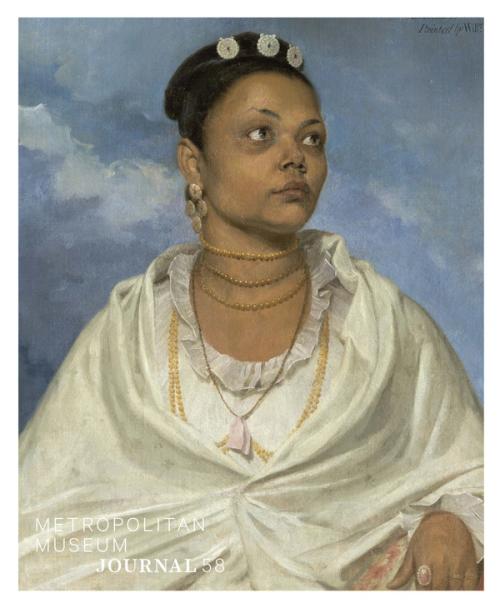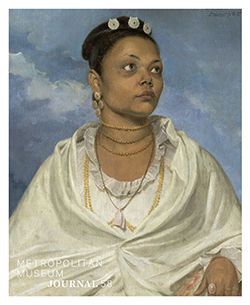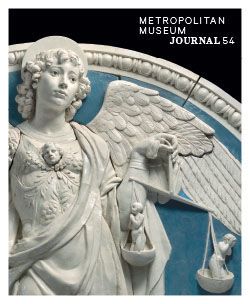MetPublications
Showing 1–10 results of 19
Sort by:
 The Metropolitan Museum Journal is issued annually and publishes original research on works of art in the Museum’s collection. Highlights of volume 58 include an investigation of how boldly colored orange glass and enamels were produced at Qing imperial workshops; a rare portrait of Joanna de Silva, an Indian servant, by British artist William Wood in 1792; and the extraordinary discovery of a hoard of German silver cups and tankards hidden for more than two hundred years.Download PDFFree to download
The Metropolitan Museum Journal is issued annually and publishes original research on works of art in the Museum’s collection. Highlights of volume 58 include an investigation of how boldly colored orange glass and enamels were produced at Qing imperial workshops; a rare portrait of Joanna de Silva, an Indian servant, by British artist William Wood in 1792; and the extraordinary discovery of a hoard of German silver cups and tankards hidden for more than two hundred years.Download PDFFree to download Download PDFFree to download
Download PDFFree to download This history of The Metropolitan Museum of Art celebrates its evolution into one of the world’s greatest museums and its vision for the future
This history of The Metropolitan Museum of Art celebrates its evolution into one of the world’s greatest museums and its vision for the future The Metropolitan Museum Journal is issued annually and publishes original research on works of art in the Museum’s collection. Highlights of volume 54 include conservators’ discoveries of Renaissance sculptor Andrea della Robbia’s workshop techniques; a new reading of lavishly dressed women on tile panels from 17th-century Iran; and John Singer Sargent’s decisive role in choosing his socialite sitters’ fashionable attire.Download PDFFree to download
The Metropolitan Museum Journal is issued annually and publishes original research on works of art in the Museum’s collection. Highlights of volume 54 include conservators’ discoveries of Renaissance sculptor Andrea della Robbia’s workshop techniques; a new reading of lavishly dressed women on tile panels from 17th-century Iran; and John Singer Sargent’s decisive role in choosing his socialite sitters’ fashionable attire.Download PDFFree to download The Metropolitan Museum of Art houses one of the world’s largest and most comprehensive collections of works of art from antiquities to modern and contemporary material. Their preservation is a responsibility shared by the many individuals employed at the Museum who have direct contact with the collection on a daily basis. The Care and Handing of Art Objects—first published in the 1940s and continually updated—offers a guide to the best practices in handling and preserving works of art while on display, in storage, and in transit. It explains many of the fundamental principles of conservation that underlie these methods. One of the goals of the publication is to make the complexities of caring for a collection readily accessible by offering basic guidelines for the preservation of the diverse materials and art objects found in The Met. Each chapter of Part I addresses a different medium ranging from paintings on canvas, works on paper, and photographs to furniture, upholstery, and arms and armor. The sections provides an overview of the particular environmental, handling, and housing factors needed to prevent damage and ensure preservation of each material. Written by experts in the respective specialty, the text summarizes the field's most critical preservation issues, many of which are amplified by photographs. Part II succinctly describes factors that affect the collection as a whole. Among these concerns the book features current environmental standards for temperature, relative humidity, light exposure, storage, and art in transit. The text also addresses integrated pest management and emergency preparedness and response. Charts on storage and display conditions as well as factors contributing to deterioration provide an easy reference for readers. A glossary of conservation terms, principles, and housing materials helps to guide for those unfamiliar with the field. The Care and Handing of Art Objects draws on the knowledge of conservators, scientists, and curators from many different departments, along with that technicians and engineers whose expertise crosses boundaries of culture, chronology, medium, and condition. It is an invaluable resource for students, collectors, small museums, museum study programs, art dealers, and members of the public who want to enhance their understanding of how works of art are safeguarded and the role environment, handling, and materials play in making this possible.Download PDFFree to download
The Metropolitan Museum of Art houses one of the world’s largest and most comprehensive collections of works of art from antiquities to modern and contemporary material. Their preservation is a responsibility shared by the many individuals employed at the Museum who have direct contact with the collection on a daily basis. The Care and Handing of Art Objects—first published in the 1940s and continually updated—offers a guide to the best practices in handling and preserving works of art while on display, in storage, and in transit. It explains many of the fundamental principles of conservation that underlie these methods. One of the goals of the publication is to make the complexities of caring for a collection readily accessible by offering basic guidelines for the preservation of the diverse materials and art objects found in The Met. Each chapter of Part I addresses a different medium ranging from paintings on canvas, works on paper, and photographs to furniture, upholstery, and arms and armor. The sections provides an overview of the particular environmental, handling, and housing factors needed to prevent damage and ensure preservation of each material. Written by experts in the respective specialty, the text summarizes the field's most critical preservation issues, many of which are amplified by photographs. Part II succinctly describes factors that affect the collection as a whole. Among these concerns the book features current environmental standards for temperature, relative humidity, light exposure, storage, and art in transit. The text also addresses integrated pest management and emergency preparedness and response. Charts on storage and display conditions as well as factors contributing to deterioration provide an easy reference for readers. A glossary of conservation terms, principles, and housing materials helps to guide for those unfamiliar with the field. The Care and Handing of Art Objects draws on the knowledge of conservators, scientists, and curators from many different departments, along with that technicians and engineers whose expertise crosses boundaries of culture, chronology, medium, and condition. It is an invaluable resource for students, collectors, small museums, museum study programs, art dealers, and members of the public who want to enhance their understanding of how works of art are safeguarded and the role environment, handling, and materials play in making this possible.Download PDFFree to download Download PDFFree to download
Download PDFFree to download Metropolitan Museum Studies in Art, Science, and Technology focuses on the reciprocal relationship between physical nature and aesthetics in the visual arts. Essays by conservators and conservation scientists present new research on the materials and technologies used in the manufacture, dating, attribution, conservation, and exhibition of works of art. This volume features an in-depth study of changing methodologies in the examination and treatment of medieval polychrome wood sculpture and ways in which they reflect broader trends in collecting and displaying these works in American museums. Two other full-length articles establish the provenience of limestone and sandstone used in Chinese and Cambodian religious foundations, respectively, through the microscopic examination of prepared thin sections that reveal their mineral components. Another article describes the results of radiographic, compositional, and microscopic examinations that confirm the authenticity of a controversial group of cast copper figures from the mountains of southwestern Lebanon. In the fifth article, the authors investigate a Spanish medieval altarpiece by employing infrared spectrometry and UV fluorescence microscopy to reveal underdrawing and paint stratigraphy that illuminate the processes of its manufacture. Six research notes describe technical studies of Egyptian hard stone sculpture, silvered Limoges enamels, an eighteenth-century French side table decorated with Japanese export lacquer, a landscape by French Pictorialist photographers, and the Metropolitan Museum's famed Lion Helmet.Download PDFFree to download
Metropolitan Museum Studies in Art, Science, and Technology focuses on the reciprocal relationship between physical nature and aesthetics in the visual arts. Essays by conservators and conservation scientists present new research on the materials and technologies used in the manufacture, dating, attribution, conservation, and exhibition of works of art. This volume features an in-depth study of changing methodologies in the examination and treatment of medieval polychrome wood sculpture and ways in which they reflect broader trends in collecting and displaying these works in American museums. Two other full-length articles establish the provenience of limestone and sandstone used in Chinese and Cambodian religious foundations, respectively, through the microscopic examination of prepared thin sections that reveal their mineral components. Another article describes the results of radiographic, compositional, and microscopic examinations that confirm the authenticity of a controversial group of cast copper figures from the mountains of southwestern Lebanon. In the fifth article, the authors investigate a Spanish medieval altarpiece by employing infrared spectrometry and UV fluorescence microscopy to reveal underdrawing and paint stratigraphy that illuminate the processes of its manufacture. Six research notes describe technical studies of Egyptian hard stone sculpture, silvered Limoges enamels, an eighteenth-century French side table decorated with Japanese export lacquer, a landscape by French Pictorialist photographers, and the Metropolitan Museum's famed Lion Helmet.Download PDFFree to download Throughout their long history, the ancient Egyptians crafted luminous statues of bronze, copper, silver, and gold for use in interactions with their gods—from ritual dramas enacted in the inner sanctuaries of temples to festival processions and celebrations attended by the multitudes. This volume, which accompanies an exhibition at The Metropolitan Museum of Art, is the first to focus on the art and significance of Egyptian metal statuary. Marshaling fresh insights to present a new appreciation of this lustrous work, the authors trace continuities in the development of the statuary, illuminate how its production was integrated within artistic and social structures, and examine its potential role in ritual practice. Metal statuary offers a surprising view of Egyptian art because the cultural, social, and manufacturing networks from which it emerged were often different from those that produced stone statuary, the more familiar artistic expression of ancient Egypt. In the presence of these extraordinary images of gods and pious individuals, the temples, in particular, emerge as crucibles in which diverse influences came together to replenish the art and beliefs of Egyptian society. The superb statues and statuettes illustrated in this volume were made in a variety of precious metals and copper alloys over a span of some two millennia. Especially dramatic are those from the Third Intermediate Period (ca. 1070–664 B.C.), an era whose conventional name belies its great artistic accomplishment. The splendid statuary from this period, the apogee of the Egyptian metalworking tradition, is perhaps best represented by the sumptuous figure of a priestess and noblewoman named "Takushit," whose entire body surface is covered with texts and depictions of god intricately inlaid with thin strips of precious metal. Also included in this volume are two essays on recent archaeological discoveries that shed light on poorly understood aspects of Egyptian metal statuary. These reports on excavations at the Sacred Animal Necropolis in North Saqqara and at the village of 'Ayn Manâwir in the Kharga Oasis yield insight into the practices surrounding temple statuary, notably that these works were provided by donors for actual use in the temple and, after many years of service, reverently decommissioned and buried in large caches. The final essay explores and explains the intricate technological aspects of Egyptian metal statuary as an integral part of its unique appeal. The technical descriptions provided for each work are thus as precise, detailed and consistent in terminology as possible—crucial considerations for a field of sculptural studies in which accurate information about manufacture and material is inextricably linked to an appreciation of the artistry and history of the medium.Download PDFFree to download
Throughout their long history, the ancient Egyptians crafted luminous statues of bronze, copper, silver, and gold for use in interactions with their gods—from ritual dramas enacted in the inner sanctuaries of temples to festival processions and celebrations attended by the multitudes. This volume, which accompanies an exhibition at The Metropolitan Museum of Art, is the first to focus on the art and significance of Egyptian metal statuary. Marshaling fresh insights to present a new appreciation of this lustrous work, the authors trace continuities in the development of the statuary, illuminate how its production was integrated within artistic and social structures, and examine its potential role in ritual practice. Metal statuary offers a surprising view of Egyptian art because the cultural, social, and manufacturing networks from which it emerged were often different from those that produced stone statuary, the more familiar artistic expression of ancient Egypt. In the presence of these extraordinary images of gods and pious individuals, the temples, in particular, emerge as crucibles in which diverse influences came together to replenish the art and beliefs of Egyptian society. The superb statues and statuettes illustrated in this volume were made in a variety of precious metals and copper alloys over a span of some two millennia. Especially dramatic are those from the Third Intermediate Period (ca. 1070–664 B.C.), an era whose conventional name belies its great artistic accomplishment. The splendid statuary from this period, the apogee of the Egyptian metalworking tradition, is perhaps best represented by the sumptuous figure of a priestess and noblewoman named "Takushit," whose entire body surface is covered with texts and depictions of god intricately inlaid with thin strips of precious metal. Also included in this volume are two essays on recent archaeological discoveries that shed light on poorly understood aspects of Egyptian metal statuary. These reports on excavations at the Sacred Animal Necropolis in North Saqqara and at the village of 'Ayn Manâwir in the Kharga Oasis yield insight into the practices surrounding temple statuary, notably that these works were provided by donors for actual use in the temple and, after many years of service, reverently decommissioned and buried in large caches. The final essay explores and explains the intricate technological aspects of Egyptian metal statuary as an integral part of its unique appeal. The technical descriptions provided for each work are thus as precise, detailed and consistent in terminology as possible—crucial considerations for a field of sculptural studies in which accurate information about manufacture and material is inextricably linked to an appreciation of the artistry and history of the medium.Download PDFFree to download Download PDFFree to download
Download PDFFree to download